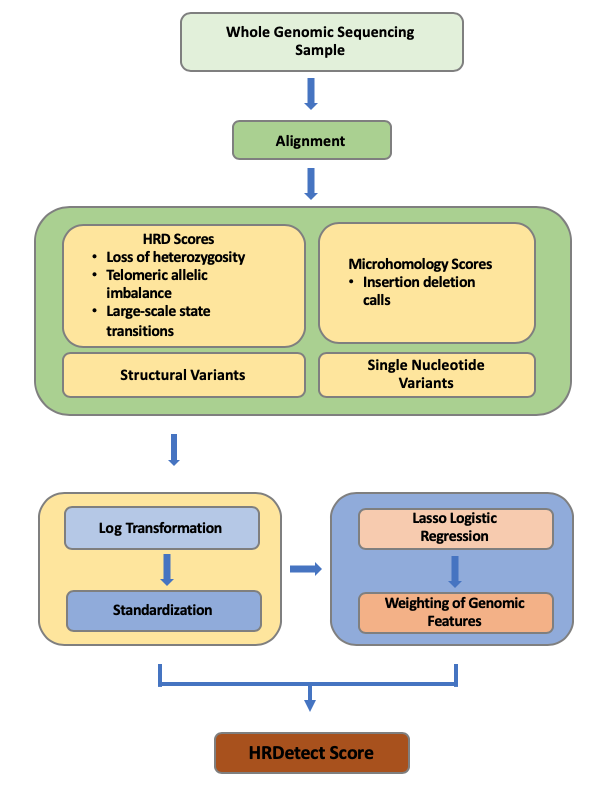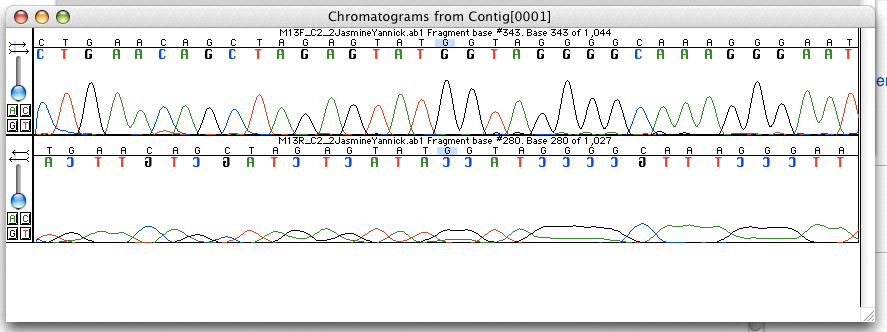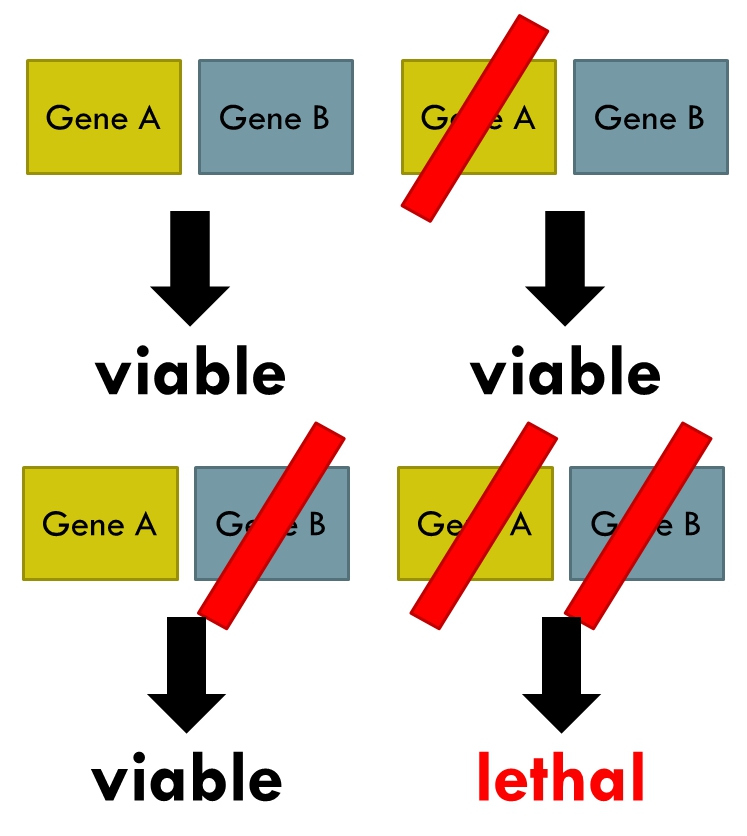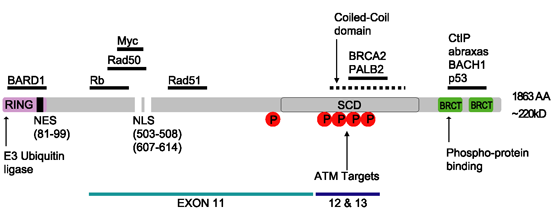|
HRDetect
HRDetect (Homologous Recombination Deficiency Detect) is a whole-genome sequencing (WGS)-based classifier designed to predict BRCA1 and BRCA2 deficiency based on six mutational signatures. Additionally, the classifier is able to identify similarities in mutational profiles of tumors to that of tumors with BRCA1 and BRCA2 defects, also known as BRCAness. This classifier can be applied to assess the implementation of Poly ADP ribose polymerase, PARP inhibitors in patients with BRCA1/BRCA2 deficiency. The final output is a probability of BRCA1/2 mutation. Background BRCA1/BRCA2 BRCA1 and BRCA2 play crucial roles in maintaining genome integrity, mainly through homologous recombination (HR) for DNA double-strand breaks (DSB)repair. The mutations of BRCA1 and BRCA2 can lead to a reduced capacity of HR machinery, increased genomic instability, and elicit a predisposition to malignancies. People with BRCA1 and BRCA2 deficiency have higher risks of developing certain cancers such as br ... [...More Info...] [...Related Items...] OR: [Wikipedia] [Google] [Baidu] |
Whole-genome Sequencing
Whole genome sequencing (WGS), also known as full genome sequencing or just genome sequencing, is the process of determining the entirety of the DNA sequence of an organism's genome at a single time. This entails sequencing all of an organism's chromosomal DNA as well as DNA contained in the mitochondria and, for plants, in the chloroplast. Whole genome sequencing has largely been used as a research tool, but was being introduced to clinics in 2014. In the future of personalized medicine, whole genome sequence data may be an important tool to guide therapeutic intervention. The tool of gene sequencing at SNP level is also used to pinpoint functional variants from association studies and improve the knowledge available to researchers interested in evolutionary biology, and hence may lay the foundation for predicting disease susceptibility and drug response. Whole genome sequencing should not be confused with DNA profiling, which only determines the likelihood that genetic ma ... [...More Info...] [...Related Items...] OR: [Wikipedia] [Google] [Baidu] |
Synthetic Lethality
Synthetic lethality is defined as a type of genetic interaction where the combination of two genetic events results in cell death or death of an organism. Although the foregoing explanation is wider than this, it is common when referring to synthetic lethality to mean the situation arising by virtue of a combination of deficiencies of two or more genes leading to cell death (whether by means of apoptosis or otherwise), whereas a deficiency of only one of these genes does not. In a synthetic lethal genetic screen, it is necessary to begin with a mutation that does not result in cell death, although the effect of that mutation could result in a differing phenotype (slow growth for example), and then systematically test other mutations at additional loci to determine which, in combination with the first mutation, causes cell death arising by way of deficiency or abolition of expression. Synthetic lethality has utility for purposes of molecular targeted cancer therapy. The first exampl ... [...More Info...] [...Related Items...] OR: [Wikipedia] [Google] [Baidu] |
Germline Mutation
A germline mutation, or germinal mutation, is any detectable variation within germ cells (cells that, when fully developed, become sperm and Egg cell, ova). Mutations in these cells are the only mutations that can be passed on to offspring, when either a mutated sperm or oocyte come together to form a zygote. After this fertilization event occurs, germ cells divide rapidly to produce all of the cells in the body, causing this mutation to be present in every Somatic (biology), somatic and germline cell in the offspring; this is also known as a constitutional mutation. Germline mutation is distinct from somatic mutation. Germline mutations can be caused by a variety of endogenous (internal) and exogenous (external) factors, and can occur throughout zygote development. A mutation that arises only in germ cells can result in offspring with a genetic condition that is not present in either parent; this is because the mutation is not present in the rest of the parents' body, only the ger ... [...More Info...] [...Related Items...] OR: [Wikipedia] [Google] [Baidu] |
Apply HRDetect
In mathematics and computer science, apply is a function that applies a function to arguments. It is central to programming languages derived from lambda calculus, such as LISP and Scheme, and also in functional languages. It has a role in the study of the denotational semantics of computer programs, because it is a continuous function on complete partial orders. Apply is also a continuous function in homotopy theory, and, indeed underpins the entire theory: it allows a homotopy deformation to be viewed as a continuous path in the space of functions. Likewise, valid mutations (refactorings) of computer programs can be seen as those that are "continuous" in the Scott topology. The most general setting for apply is in category theory, where it is right adjoint to currying in closed monoidal categories. A special case of this are the Cartesian closed categories, whose internal language is simply typed lambda calculus. Programming In computer programming, apply applies a function ... [...More Info...] [...Related Items...] OR: [Wikipedia] [Google] [Baidu] |
6 Mutational Signatures
6 (six) is the natural number following 5 and preceding 7. It is a composite number and the smallest perfect number. In mathematics A six-sided polygon is a hexagon, one of the three regular polygons capable of tiling the plane. A hexagon also has 6 edges as well as 6 internal and external angles. 6 is the second smallest composite number. It is also the first number that is the sum of its proper divisors, making it the smallest perfect number. It is also the only perfect number that doesn't have a digital root of 1. 6 is the first unitary perfect number, since it is the sum of its positive proper unitary divisors, without including itself. Only five such numbers are known to exist. 6 is the largest of the four all-Harshad numbers. 6 is the 2nd superior highly composite number, the 2nd colossally abundant number, the 3rd triangular number, the 4th highly composite number, a pronic number, a congruent number, a harmonic divisor number, and a semiprime. 6 is also the first ... [...More Info...] [...Related Items...] OR: [Wikipedia] [Google] [Baidu] |
Loss Of Heterozygosity
In genetics, loss of heterozygosity (LOH) is a type of genetic abnormality in diploid organisms in which one copy of an entire gene and its surrounding chromosomal region are lost. Since diploid cells have two copies of their genes, one from each parent, a single copy of the lost gene still remains when this happens, but any heterozygosity (slight differences between the versions of the gene inherited from each parent) is no longer present. In cancer The loss of heterozygosity is a common occurrence in cancer development. Originally, a heterozygous state is required and indicates the absence of a functional tumor suppressor gene copy in the region of interest. However, many people remain healthy with such a loss, because there still is one functional gene left on the other chromosome of the chromosome pair. The remaining copy of the tumor suppressor gene can be inactivated by a point mutation or via other mechanisms, resulting in a loss of heterozygosity event, and leaving no tumo ... [...More Info...] [...Related Items...] OR: [Wikipedia] [Google] [Baidu] |
Train HRDetect
A train (from Old French , from Latin">-4; we might wonder whether there's a point at which it's appropriate to talk of the beginnings of French, that is, when it wa ... , from Latin , "to pull, to draw") is a series of connected vehicles that run along a railway track and Passenger train, transport people or Rail freight transport, freight. Trains are typically pulled or pushed by locomotives (often known simply as "engines"), though some are self-propelled, such as multiple units or railcars. Passengers and cargo are carried in railroad cars, also known as wagons or carriages. Trains are designed to a certain gauge, or distance between rails. Most trains operate on steel tracks with steel wheels, the low friction of which makes them more efficient than other forms of transport. Many countries use rail transport. Trains have their roots in wagonways, which used railway tracks and were powered by horses or pulled by cables. Following the invention of the steam locomotive i ... [...More Info...] [...Related Items...] OR: [Wikipedia] [Google] [Baidu] |
BRCA PARP Twohit
Brca or BRCA may refer to: * Brca (Bar Municipality), a village in Macedonia * ''BRCA'' mutation, mutations in two genes which produce a hereditary breast-ovarian cancer syndrome **''BRCA1'', the first of these genes to be discovered **''BRCA2 ''BRCA2'' and BRCA2 () are human genes and their protein products, respectively. The official symbol (BRCA2, italic for the gene, nonitalic for the protein) and the official name (originally breast cancer 2; currently BRCA2, DNA repair associate ...'', the second of these genes to be discovered * British Radio Car Association, a British radio controlled car racing organisation * Brotherhood Railway Carmen of America, a defunct American trade union * Bureau Central de Renseignements et d'Action, the Free French intelligence agency during World War II {{disambiguation ... [...More Info...] [...Related Items...] OR: [Wikipedia] [Google] [Baidu] |
BRCA1
Breast cancer type 1 susceptibility protein is a protein that in humans is encoded by the ''BRCA1'' () gene. Orthologs are common in other vertebrate species, whereas invertebrate genomes may encode a more distantly related gene. ''BRCA1'' is a human tumor suppressor gene (also known as a caretaker gene) and is responsible for repairing DNA. ''BRCA1'' and ''BRCA2'' are unrelated proteins, but both are normally expressed in the cells of breast and other tissues, where they help repair damaged DNA, or destroy cells if DNA cannot be repaired. They are involved in the repair of chromosomal damage with an important role in the error-free repair of DNA double-strand breaks. If ''BRCA1'' or ''BRCA2'' itself is damaged by a BRCA mutation, damaged DNA is not repaired properly, and this increases the risk for breast cancer. ''BRCA1'' and ''BRCA2'' have been described as "breast cancer susceptibility genes" and "breast cancer susceptibility proteins". The predominant allele has a no ... [...More Info...] [...Related Items...] OR: [Wikipedia] [Google] [Baidu] |
Genomic Instability
Genome instability (also genetic instability or genomic instability) refers to a high frequency of mutations within the genome of a cellular lineage. These mutations can include changes in nucleic acid sequences, chromosomal rearrangements or aneuploidy. Genome instability does occur in bacteria. In multicellular organisms genome instability is central to carcinogenesis, and in humans it is also a factor in some neurodegenerative diseases such as amyotrophic lateral sclerosis or the neuromuscular disease myotonic dystrophy. The sources of genome instability have only recently begun to be elucidated. A high frequency of externally caused DNA damage can be one source of genome instability since DNA damage can cause inaccurate translesion DNA synthesis past the damage or errors in repair, leading to mutation. Another source of genome instability may be epigenetic or mutational reductions in expression of DNA repair genes. Because endogenous (metabolically-caused) DNA damage is very ... [...More Info...] [...Related Items...] OR: [Wikipedia] [Google] [Baidu] |
Homologous Recombination
Homologous recombination is a type of genetic recombination in which genetic information is exchanged between two similar or identical molecules of double-stranded or single-stranded nucleic acids (usually DNA as in Cell (biology), cellular organisms but may be also RNA in viruses). Homologous recombination is widely used by cells to accurately DNA repair, repair harmful DNA breaks that occur on both strands of DNA, known as double-strand breaks (DSB), in a process called homologous recombinational repair (HRR). Homologous recombination also produces new combinations of DNA sequences during meiosis, the process by which eukaryotes make gamete cells, like sperm and ovum, egg cells in animals. These new combinations of DNA represent genetic variation in offspring, which in turn enables populations to Adaptation, adapt during the course of evolution. Homologous recombination is also used in horizontal gene transfer to exchange genetic material between different strains and species ... [...More Info...] [...Related Items...] OR: [Wikipedia] [Google] [Baidu] |







